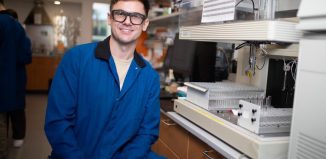BNL’s Aaron Stein studies the incredibly small
Keeping a lab humming when working with nanomaterials
Aaron Stein was hired to work at a place that existed only on paper. About a decade ago, the physicist agreed to work at Brookhaven National Lab’s Center for Functional Nanomaterials, even though BNL hadn’t started construction on the cutting edge facility.
“I see something that went from an idea to a hole in the ground to a place where lots of science is being done,” Stein said.
Indeed, Stein, who earned a Ph.D. in physics from Stony Brook University, was the first official hire at the CFN, which is one of only five nanoscale science research centers funded by the Department of Energy’s Office of Science.
The study of nanomaterials involves examining how to exploit or understand physical and chemical changes that occur at an incredibly small scale. While construction of a skyscraper follows certain laws of physics — such as how much weight a load-bearing wall can support — the manufacture of objects, such as fuel cells or computer parts, is guided by other forces and interactions.
“There are certain things you’d never see otherwise if not for shrinking them down to that size scale, either due to quantum effects, size effects — you have more surface area — or other things,” Stein explained. “Everything changes and gets weird and interesting on the nano scale.”
Stein has worked in nanomagnetism, X-ray optics and photovoltaics, among many others.
Working with nanomagnets isn’t all that different, he explained, from using the bar magnets children use in middle school, except that the scale, functionality and experiments are considerably altered.
“The side I’m on is in making these magnets,” he said. “We make millions of these magnets at a time and play with the physics. We’re building our own little playground to test theories and observe” the results.
Stein has worked with Kenneth Evans-Lutterrodt, a staff scientist at BNL, since his days as a Ph.D. candidate at Stony Brook. The two have worked for years developing and honing miniature lenses that could have applications ranging from creating higher resolution and better contrast diagnostic X-ray images all the way to looking at the stress, on an atomic level, of a helicopter bearing.
“We have spent many years developing the ideas behind this,” Evans-Lutterodt said. “We look at what new design to try. He does the e-beam lithography.”
In e-beam lithography, a tiny piece of silicon is coated with a material called a resist. The material scientists like Stein uses varies, depending on what they are trying to manufacture. The researcher shoots an electron beam at the resist. The resist is sensitive to electrons in the same way that film is sensitive to light: after exposure, it is developed and the contrast can be used to create structures or finely crafted objects that are of almost any shape and size, Stein said.
Evans-Lutterodt uses the lenses Stein makes in collaborations with other scientists. The lenses themselves, he said, are not like the ones that sit in prescription glasses: they have considerably more curvature.
“The shape is quite asymmetric,” Evans-Lutterodt said. “It’s very difficult to bend X-rays. The lenses are also made out of silicon, which is opaque to visible light, but somewhat transmissive to X-ray.”
As far as a commercial application, Evans-Luterrodt said he would expect it to take about three years, optimistically, before he and Stein had developed a commercial application from their research.
Stein’s goal is to “enable science.”
As for his own work, much of it is in understanding the limits of the tools and the materials he is employing.
“A big part of the job,” he said, “is to keep the lab humming.” That includes making sure the equipment is maintained, the supplies are available, and the tools are in the same condition for everyone.
Stein also spends considerable time focusing on the environmental components of nanofabrication, ensuring that everyone who comes into the lab goes home safely.
A resident of Huntington, Stein is married to Sasha Abraham, who is a member of an advocacy group that works on prostate awareness and screening. They have an 11-year-old daughter, Lily, and a 9-year-old son, Henry.
Stein grew up in Syracuse and said he never imagined coming to Long Island to build his life and career.
“There are a narrow set of places I could work,” he explained. “Probably, where I am now, is really an ideal situation for me.”






